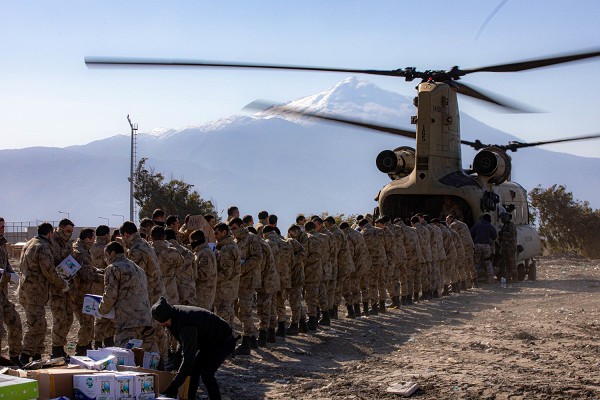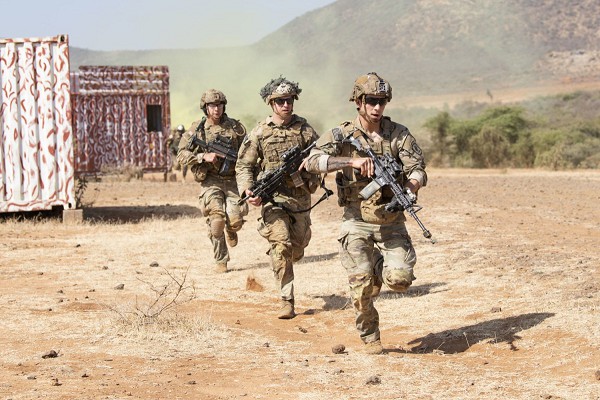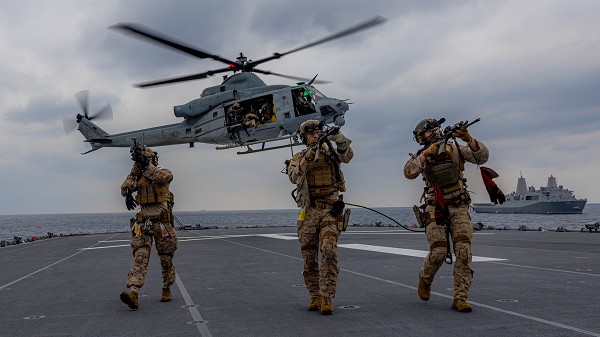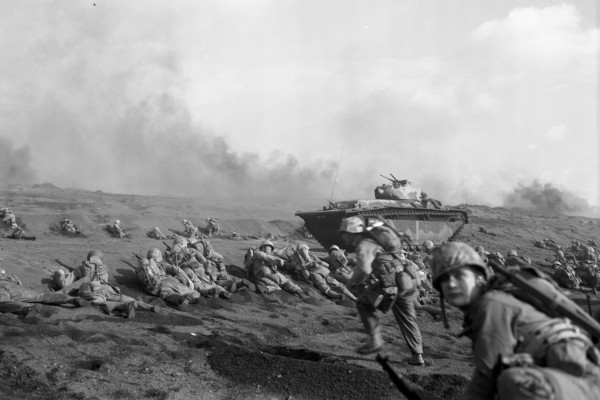- Details
- Hits: 457

Incirlik Air Base, Türkiye. (March 13, 2023): As the tragic number of earthquake victims continues to rise, America’s military is doing its part to provide comfort and relief to the thousands of Turkish civilians who need it. In the above photo by Specialist William Thompson, an Army CH-47F Chinook helicopter assigned to 3rd Battalion, 501st Aviation Regiment, Combat Aviation Brigade of the 1st Armored Division takes on relief supplies for delivery on behalf of the American people.
As of March 13th , more than 55,700 deaths were confirmed in Turkey and Syria and an estimated 1.5 million are homeless. According to the Turkish government, more than 160,000 buildings containing 520,000 apartments collapsed or were severely damaged during the quake forcing survivors to bed down in tents, factories, train cars, and even greenhouses. As these victims struggle against cold and hunger, American choppers are bringing tons of essential supplies to hard hit areas that are impossible to reach by road. The 3rd Battalion’s two Chinooks delivered 40,000 pounds of humanitarian aid from Incirlik Air Base to Elbistan and Pazarcik including tents, hygiene products, and diapers. The 3rd Battalion flew 10 air missions totaling more than 60 flight hours to support the United States Agency for International Development, or USAID, and Turkish relief efforts.
- Details
- Hits: 592

Oman. (February 29, 2023): Terrorists and their schemes never sleep. They won’t be getting much sleep when they realize they are being pursued by the U.S. Marines and our allies the Royal Oman Police. In the U.S. Army photo above, the Marines Fleet Anti-Terrorism Security Team (Central Command) and the Omani Special Task Unit conduct live fire exercises as part of Invincible Sentry 23. This recurring exercise brings together partner nations to coordinate responses to terrorist threats to the region.
The Fleet Anti-Terrorism Security Team organizes, trains, equips, and provides anti-terrorism security forces for expeditionary forces guarding American interests in the Central Command region. The Team provides strategic weapons and training to provide dedicated security and anti-terrorism protection of high-value naval installations, most notably those containing nuclear vessels and weapons.
Fleet Anti-terrorism Security Team (FAST) platoons are capable of rapidly deploying around the world to immediately improve security at United States government installations under threat. These units are experts at special operations, including advanced close quarter battle and in-extremis hostage rescue. Established in 1987, FAST platoons are forward deployed at various naval commands to rapidly respond to unforeseen contingencies worldwide. Each FAST company is made up of 500 Marines equipped and trained with the most state-of-the-art weaponry available.
- Details
- Hits: 442

Isiolo, Kenya. (February 23, 2023): In this photo by Sergeant Christian Dela Cruz, U.S. Army paratroopers assigned to Chosin Company, 2nd Battalion, 503rd Parachute Infantry Regiment, 173rd Airborne Brigade demonstrate combat tactics during Exercise Justified Accord 23 hosted by the government of Kenya. This is the U.S. Africa Command’s largest exercise, led by the Army’s Southern European Task Force Africa, involving 20 countries to increase readiness for peacekeeping, crisis response, and humanitarian assistance missions.
The highlight of Justified Accord 23 involved over 1,000 participants holding live-fire field training exercises that included the 173rd Airborne Brigade, 2nd Security Forces Assistance Brigade, the 720th Explosive Ordnance Disposal Detachment and the 352nd Civil Affairs Command. The Massachusetts State National Guard provided sustainment support for Kenyan Defense Forces as part of a long-standing partnership.
- Details
- Hits: 430

Pacific Ocean. (March 4, 2023): In this photo by Sergeant Marcos A. Alvarado, U.S. Marines with the maritime raid force 31st Marine Expeditionary Unit conduct a search during a visit, board, search, and seizure (VBSS) exercise aboard the tank landing ship JS Osumi during Exercise Iron Fist 23.
Iron Fist 23 provided an opportunity for the USS America Amphibious Ready Group and the Japanese Maritime Self Defense Force to work together in combined counter-piracy operations at sea. The 31ST Marine Expeditionary Unit (MEU) serves as America’s forward deployed, quick response force capable of responding immediately to crises around the world. Commanded by a Marine colonel, the 31st MEU is comprised of approximately 2,200 Marines and Sailors embarked aboard three or four amphibious ships.
Iron Fist 23 is an annual field training exercise designed to increase interoperability and strengthen the relationship between the Marine Corps, Navy, and the Japanese Self Defense Force. This year’s exercise simulated an island seizure involving airborne and battalion landing teams working with their Japanese counterparts.
Visit, board, search, and seizure exercises practice maritime boardings of suspect vessels at sea and is one of the more dangerous peacetime missions for the Navy. These boarding teams capture enemy vessels, combat terrorism, stop piracy, and prevent smuggling of contraband or human traffic. These highly trained professionals undergo eight weeks of training in close quarter battle, shooting, rappelling, and search and seizure procedures. Marines are trained to fast rope from helicopters onto potentially hostile vessels and use their tactical skills to subdue and seize the ship and its crew. As one can imagine, the school’s dropout rate is unusually high, around 30% fail to qualify.
- Details
- Hits: 592

Washington, D.C. (February 13, 2023): You can see the terror that was Iwo Jima on their faces. In this National Archives photo by Bob Campbell, members of 2nd Battalion, 27th Marine Regiment, land on the island seventy-eight years ago. Sadly, the participants of this epic battle have faded into history, but their memory remains in the proud young Marines of today.
U.S. Marines invaded Iwo Jima on February 19, 1945, after months of naval and air bombardment. The Japanese defenders were dug into bunkers deep within the volcanic rocks. Approximately 70,000 U.S. Marines and 18,000 Japanese soldiers took part in the battle.
In thirty-six days of fighting, nearly 7,000 U.S. Marines were killed and another 20,000 wounded. Marines captured 216 Japanese soldiers; the rest were killed in action. The island was finally declared secured on March 26th after one of the bloodiest battles in Marine Corps history. After the battle, Iwo Jima served as an emergency landing site for more than 2,200 B-29 bombers, saving the lives of 24,000 U.S. airmen. Securing Iwo Jima prepared the way for the last and largest battle in the Pacific: the invasion of Okinawa.
Read more: BATTLE OF IWO JIMA TURNED THE TIDE OF THE PACIFIC WAR
- Details
- Hits: 505

CHIÈVRES AIR BASE, Belgium (March 3,2030): In the early stages of any conflict, America’s military will need to launch aircraft from remote locations all over the world, some without runways, buildings, or infrastructure. In this photo by Staff Sergeant Alexandra Longfellow, Air Force Staff Sgts. Mason E-Quantay, top, and Jesus Solis-Zavala, right, 435th Security Forces Squadron contingency response team members, provide security during Exercise Agile Bison 23-1. An Air Force Contingency Response Squadron deploys a unique blend of civil engineers, construction specialists, and air operations folks to forward locations where air operations are nonexistent. These teams establish airfields, construct buildings, and provide water and sanitation to remote locations, often under the threat of enemy fire.
Once an airfield is opened, the Squadron does quick-turn maintenance of aircraft, airfield management, passenger and cargo movement, air traffic control, and force protection. The 435th Security Force is an airborne capable squadron based at Pulaski Barracks, Germany, whose mission is to secure, protect, and defend Air Force weapons systems, personnel, and resources in Europe.
During Exercise Agile Bison 23-1, the 435th established expeditionary airfields using NATO allies and partner bases along with the group’s own personnel, logistics and equipment, while also maintaining force protection during high threat levels.
Exercises like Agile Bison provide realistic training with our NATO allies under a variety of scenarios, from parachuting into forward areas to create runways to defending these remote airfields from enemy attack. In war, victory or defeat might well be decided on which force managed to project air power to far flung locations around the globe.
- FLYING GAS STATION EXTENDS AMERICA’S REACH
- Older than the crews that fly them… B-52 BOMBER IS STILL AMERICA’S “BACKBONE”
- All Choked Up! AIR FORCES SECURITY TRAINS FOR DUAL ROLE
- SAILORS VOLUNTEER FOR LIFE BENEATH THE WAVES
- FINAL HONORS AS AMERICAN HERO COMES HOME
- SPANISH TROOPS DEPLOY WITH U.S SIXTH FLEET


